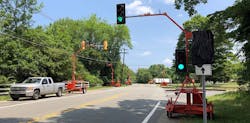ATSSA explores work zone technology applications
The American Traffic Safety Services Association (ATSSA) collaborates with roadway safety infrastructure industry professionals each year to produce case studies that offer insights into key issues with the goal of saving lives.
One of those studies examined “Innovative Technology Applications in Work Zones,” a topic of critical importance to ATSSA and everyone who travels the nation’s roadways. It looked at what is being done in the DOTs in Iowa and Michigan.
Technological innovations continue to improve work zone safety. The “smart work zone” offers potential safety benefits to motorists, flaggers, and workers, as an increasing array of devices can provide real-time information to promote safer driver behavior.
The Iowa DOT’s Smart Work Zone Expansion Group developed a requirement for the use of smart arrow boards on all interstate projects beginning with the October 2020 contract letting season.
Smart arrow boards are equipped with a cellular modem and GPS antenna. They capture data on the starting point of work zone lane closures. Navigation apps can use this information to warn drivers of upcoming lane closures in real time.
To ease the integration of these smart arrow boards, all of Iowa’s smart work zone device information is routed through central traffic management software. Iowa DOT requires all rented work zone devices to be configured to communicate with their existing software.
To improve traffic management at driveway entry locations on two-way roads, the Michigan DOT (MDOT) deployed the Driveway Assistance Device (DAD).
The DAD is a portable, trailer-mounted traffic signal head that can be placed at driveway entrances to one-lane work zones. It is meant to supplement other traffic control devices and flaggers within the work zone and can help motorists safely enter the work zone through the display of traffic signals. Since it started piloting the DAD in 2015, MDOT has gotten the per-unit price down to $1,950. MDOT determined that the DAD is most appropriate for low-volume driveways.
Other innovative technologies explored include:
- Automated Flagger Assistance Devices (AFAD), which allow properly trained flaggers to control traffic from a safe location off the shoulder of the roadway.
- Worksite Access Systems, which use sensors to trigger flashing lights that alert motorists of trucks entering the traffic space from the workspace, reducing close calls and improving awareness of the speed variance between motorists and trucks entering traffic.
- Smart Work Zone Sensors, which can provide real-time data on the location of work zones, the location of devices, maintenance needs, and other information.
Editor's Note: Scranton Gillette Communications and the SGC Infrastructure Group are not liable for the accuracy, efficacy and validity of the claims made in this piece. The views expressed in this content do not reflect the position of the Roads & Bridges' Editorial Team.

